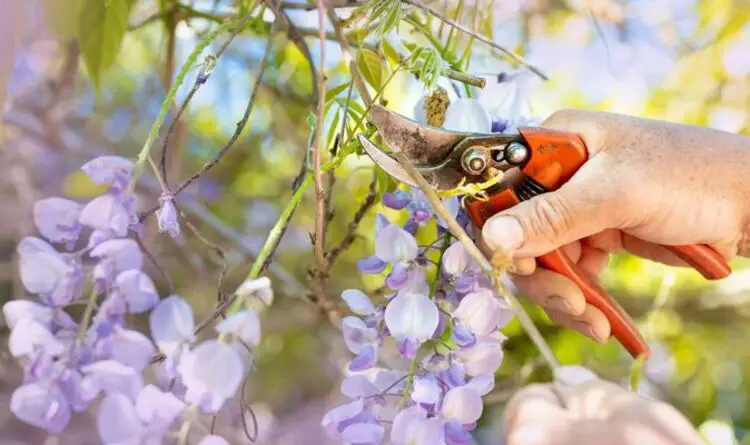Wisteria’s breathtaking cascades of purple and white blooms can transform any garden into a romantic dream—but only if you prune it at the right time. One wrong cut in the wrong season, and you might miss out on those spectacular flowers for an entire year.
The key to unlocking wisteria’s full potential lies in understanding when and how to prune without damaging future blooms. Whether you’re a first-time grower or nurturing an older vine, mastering the timing will help your wisteria flourish with elegance and abundance season after season.
Understanding Wisteria’s Growth Cycle

To prune wisteria effectively without harming next year’s flowers, it’s essential to understand the plant’s natural growth cycle. Wisteria is a vigorous, twining vine that goes through distinct seasonal phases, each playing a critical role in how and when blooms are produced.
In early spring, wisteria awakens from dormancy and channels its energy into producing leaf buds and, in mature plants, clusters of flower buds that were formed during the previous summer. These buds open into blooms before or alongside the new foliage. After flowering, the vine rapidly shifts to producing long, leafy shoots. This vegetative growth can become unruly, but it’s also necessary for photosynthesis and future bud formation.
As summer progresses, flower buds for the next year begin to develop on the current season’s woody growth. These tiny buds remain dormant through fall and winter, waiting to bloom the following spring. If you prune at the wrong time—especially late fall or early spring—you risk cutting off these developing or dormant buds and reducing or eliminating next year’s display.
By aligning your pruning schedule with this cycle—light pruning in summer to shape the plant and reduce excess growth, and structural pruning in late winter before the buds swell—you support both the health of the vine and the promise of abundant future flowers.
Best Times of Year to Prune Wisteria
Signs You’re Pruning at the Right Time
Knowing when to prune wisteria can be the difference between a stunning floral display and a flowerless season. Observing the plant’s cues and aligning your timing with its growth cycle ensures you’re not removing next year’s flower buds or encouraging unmanageable growth. Here are the most reliable signs that you’re pruning at the ideal time for your wisteria’s health and blooming success.
After the First Flower Flush in Summer
If your wisteria has just finished its first major bloom in late spring or early summer, this is the perfect window for the first pruning. You’ll notice the flowers begin to fade, followed by an explosion of long, green shoots—some growing several feet in a matter of weeks. This new vegetative growth signals that the plant is entering its active summer phase, making it an ideal moment to redirect energy from stem elongation to flower bud formation for the next year. When the green shoots are still soft and pliable, they’re easier to prune and respond better to shaping.
Dormant Vines in Late Winter
In late winter, the wisteria vine becomes bare and dormant. This is the most forgiving time to perform structural pruning without risking damage to emerging buds. The lack of foliage reveals the full branching structure, allowing you to easily identify and remove unnecessary or overly long stems. A key sign you’ve hit the right pruning window is when daytime temperatures begin to rise slightly, but buds have not yet begun to swell or break open. This timing protects developing flower buds while still giving the plant time to heal before active growth resumes.
Buds Are Still Tight and Compact
When preparing for the second pruning in late winter or early spring, examine the buds closely. You’re pruning at the right time if the flower and leaf buds are still tight, compact, and have not begun to elongate or show color. Pruning at this stage reduces the risk of damaging developing blooms. If the buds are beginning to swell or open, it’s best to delay or be extremely cautious, as cutting now could remove potential flowers.
Vigorous Summer Growth Has Slowed
Another sign you’re timing summer pruning well is a noticeable slowdown in rapid vine growth. Once the long, leafy tendrils from spring have reached a certain length—typically by mid to late summer—and begin to mature and stiffen slightly, it’s a good time to prune them back. This window gives the plant enough time before dormancy to start forming the short flowering spurs that will bloom the following year.
Consistent Annual Blooming Patterns
Over time, your wisteria will develop predictable blooming and growth cycles. If your vine blooms reliably each spring and remains structurally balanced with controlled foliage, it’s a strong sign that your pruning has been well timed. In contrast, a year with poor flowering or excessive growth may suggest pruning was done too early, too late, or not at all. Tracking bloom time and growth year after year helps you fine-tune your pruning schedule.
Recognizing these signs and adjusting your pruning practice accordingly not only improves the health of your wisteria but also enhances its flowering performance year after year.
What Happens If You Prune at the Wrong Time
Cutting in Fall or Early Spring Risks Bloom Loss
Wisteria forms its flower buds during late summer and fall, preparing for the next spring’s spectacular display. If you prune in the fall—especially after September—you risk cutting off those crucial buds just as they are setting in. These buds are not always obvious to the untrained eye, making fall pruning particularly risky. The result can be a flowerless spring, which often disappoints gardeners who otherwise cared well for their vine.
Similarly, pruning heavily in early spring—after dormancy but just as the buds begin to swell or emerge—can also lead to bloom loss. This is because those visible, swollen buds are often flower buds. Removing them eliminates the upcoming bloom entirely. While light shaping is sometimes necessary, major cuts should be avoided once buds are noticeably enlarging. If you see small, fuzzy or rounded buds on short spurs along older wood, those are likely flower buds—handle them with care.
Timing is everything with wisteria, and understanding the invisible work it does beneath the surface in fall and early spring helps preserve its full flowering potential.
Over-Pruning Leads to Excess Leaf Growth
Wisteria is a naturally vigorous plant, and when it senses injury—especially excessive pruning—it responds with a survival mechanism: producing long, fast-growing shoots and lush foliage. This is particularly common when too much wood is removed in a single session or when pruning is done out of sync with its growth cycle.
This excess vegetative growth consumes much of the plant’s energy, which would otherwise go toward flower bud development. Instead of focusing on bloom production, the wisteria shifts into a defensive state, generating more stems and leaves to recover from the loss. These shoots, often called “whips,” can grow several feet in just weeks, making the vine even more difficult to manage.
To avoid this issue, prune in moderation and follow the two-stage schedule—once in midsummer to control growth and again in late winter to shape and refine. Regular, balanced pruning sends the message to the plant that all is well and encourages it to invest energy in flowering, not just foliage.
How Climate Zones Affect Pruning Timing
Cool Climates May Delay Growth and Pruning Needs
In cooler climates, such as USDA Zones 5 to 7, wisteria breaks dormancy later in the season due to prolonged cold. As a result, both growth and blooming are delayed by several weeks compared to warmer regions. This shift also affects pruning timing—winter pruning should be postponed until late February or early March, just before new buds swell but while the plant is still fully dormant. Summer pruning may need to wait until August if blooming extends into July.
Because low temperatures slow overall growth, wisteria in cool climates may produce fewer long shoots and require less aggressive summer pruning. Paying close attention to local weather patterns ensures that pruning enhances flowering instead of inadvertently removing future blooms.
Warm Climates Require Earlier Scheduling
In warm regions like USDA Zones 8 to 10, wisteria often wakes from dormancy as early as late January or early February. This accelerated growth cycle means both winter and summer pruning should be done earlier. Winter pruning is best completed by mid-January to avoid cutting emerging buds, while summer pruning may start as early as June, shortly after the first flush of flowers fades.
Because vines grow more vigorously in warm climates, timely pruning is essential to prevent overgrowth and maintain flower production. An early and consistent schedule helps control the plant’s shape, encourage bud development, and avoid accidentally removing next season’s blooms.
Tools and Techniques for Safe Pruning
Pruning wisteria well means using the right tools at the right time. Use sharp, clean bypass pruners for small stems and loppers or a saw for thick vines. Sterilize tools with alcohol or bleach before and after use to prevent disease.
Cut just above a healthy bud at a slight angle for clean healing. In summer, trim long shoots to six to eight buds. In winter, cut them back to two or three. Start by removing dead or weak wood, then shape the vine gradually. Avoid pruning when vines are wet to reduce the risk of infection. With care and clean cuts, your wisteria will stay healthy and bloom beautifully each year.
How to Prune Young Wisteria for Future Blooms
Establishing a strong framework during the early years of a wisteria vine’s life is crucial for promoting healthy growth and abundant flowering later on. Proper early pruning not only trains the plant’s shape but also encourages the development of short, flowering spurs rather than long, unproductive vines. Each stage of early pruning serves a unique purpose in building a productive, manageable plant.
First-Year Structural Pruning
During the first year after planting, focus on establishing a strong central leader and a few main lateral branches. If your young wisteria was grown from seed or a cutting, it may not bloom for several years, but pruning from the beginning lays the foundation for future success. Select one vigorous shoot to become the main trunk and remove all other competing stems. Tie the main shoot to a sturdy support, such as a pergola post or wire trellis, to guide upward growth. In midsummer, trim back side shoots to about six inches to encourage the development of flowering spurs.
Second and Third Year: Encouraging a Balanced Framework
By the second growing season, the focus shifts to forming the permanent structure that will support future blooms. Allow the central leader to continue climbing, but regularly prune lateral shoots that extend more than six to eight inches from the main stem. These side shoots will eventually bear flower buds, so shaping them early is important. Prune in midsummer and again in late winter to shorten long laterals and stimulate spur growth.
By the third year, your wisteria should have developed a recognizable framework. Continue to remove any weak, tangled, or overly vigorous shoots that compromise the structure. This regular pruning keeps the plant open to sunlight and air circulation, two important factors in flower bud formation.
Managing Non-Flowering Vines in Young Plants
It’s common for young wisteria, especially those started from seed, to focus on vegetative growth rather than blooming in their early years. If your plant remains flowerless by the third or fourth year, examine whether it’s receiving enough sunlight—wisteria needs full sun for best bloom performance. Over-fertilization, especially with nitrogen-rich products, can also delay flowering. To redirect energy away from foliage and toward reproduction, maintain consistent summer and winter pruning, trimming back whippy growth and stimulating flower spur development.
Through patient shaping, correct pruning, and a little restraint on feeding, young wisteria can be transformed into prolific bloomers over time, rewarding you with lush, cascading flowers year after year.
Pruning Tips for Older, Overgrown Vines
Older wisteria vines that haven’t been pruned for years often grow out of control and stop blooming. Restoring them requires a thoughtful approach spread over multiple seasons. With consistent care, even the wildest vine can bloom again.
Start with a Structural Clean-Up
Begin by removing any dead, damaged, or diseased wood to allow the plant to refocus its energy. Next, cut out suckers growing from the base and clear away tangled or congested stems that block air and light. If the vine is dense, remove up to one-third of the oldest, thickest branches in the first year to open up the framework and prevent shock.
Use a Multi-Year Restoration Plan
Don’t try to rejuvenate an old vine all at once. Spread your efforts over two or three years to avoid over-stressing the plant. In year one, focus on establishing a clear structure by identifying strong main stems and reducing extra growth. In year two, further refine the form and begin developing flowering spurs. By year three, the vine should be easier to manage and more likely to bloom.
Encourage Flowering Spurs with Targeted Cuts
To promote blooming, prune lateral shoots in summer back to three to five buds. These cuts encourage the formation of flowering spurs close to the main framework. In late winter, return to these same shoots and trim them again, leaving only two to three buds. This method gradually shifts the plant’s energy from vine production to flower development.
Prioritize Safety and Structural Support
Old wisteria can be heavy, so inspect arbors or trellises before pruning. Reinforce or replace any parts that can’t support the vine’s weight. Always use sharp, sterilized tools to make clean cuts that heal well. Wear gloves and protective clothing to avoid scratches from thick stems. With consistent pruning and patience, even neglected vines can return to full bloom and vibrant growth.
Common Pruning Mistakes and How to Avoid Them
Pruning at the Wrong Time
One of the most frequent mistakes is pruning wisteria at the wrong point in its growth cycle. Cutting back in fall may remove the developing flower buds that are formed over the summer and fall for next year’s blooms. Similarly, pruning too late in early spring—after buds begin to swell—can damage or eliminate those same buds.
How to avoid it: Always follow the two-pruning method—once in midsummer (July or August), and again in late winter or very early spring (January to March), before buds emerge.
Over-Pruning the Vines
Aggressively cutting back too much at once often triggers the plant to produce excessive leafy growth instead of flowers. Wisteria responds to heavy pruning by shifting energy to regrow stems and foliage, delaying flower production.
How to avoid it: Only remove one-third of the vine’s growth at any one pruning session, and preserve flowering spurs with 2–3 buds during winter pruning.
Letting Whippy Shoots Take Over
Fast-growing, thin “whippy” shoots are common on wisteria, especially after flowering. If left untrimmed, they form a tangled mess that diverts energy from flower development and reduces airflow and sunlight.
How to avoid it: In summer, cut these shoots back to six or seven buds. This trains the vine and channels energy toward bloom formation.
Forgetting to Remove Dead or Diseased Wood
Old, dead, or diseased stems not only reduce flowering but also increase the risk of pest infestations and fungal issues. These can easily go unnoticed in dense growth.
How to avoid it: During each pruning session, inspect the base and canopy for brittle, discolored, or hollow stems. Remove these cleanly with sterilized tools.
Using the Wrong Tools or Techniques
Using dull, dirty, or inappropriate tools can crush stems and introduce pathogens. Jagged cuts also heal poorly, making plants more vulnerable to disease.
How to avoid it: Always use clean, sharp bypass pruners or loppers. Wipe blades with alcohol before and after pruning. Make clean, angled cuts just above a healthy bud or node to promote quick healing.
Avoiding these mistakes helps your wisteria thrive, bloom more reliably, and remain manageable for years to come.
FAQ about Pruning Wisteria
When is the best time to prune wisteria?
The best time to prune wisteria is twice a year—once in midsummer (July or August) and again in late winter or early spring (January to March), depending on your local climate. The midsummer pruning controls excessive leafy growth and encourages flower bud formation. The late winter pruning refines the vine’s structure and enhances the quality of blooming. Avoid pruning in the fall, as this is when flower buds begin forming for the following year.
What happens if I prune wisteria at the wrong time?
Pruning at the wrong time—especially in fall or early spring when flower buds are forming or already developed—can reduce or eliminate blooms for the coming season. Cutting back too early or too late may remove flower buds by accident. Over-pruning can also trigger the plant to produce lots of leaves instead of flowers, as it tries to recover from stress.
How do I prune wisteria for more flowers?
To promote more blooms, follow the two-pruning approach: prune long green shoots back to 6–8 buds in midsummer, then shorten those same shoots again in late winter to just 2–3 buds. This technique redirects the plant’s energy from vegetative growth to flower production. Also, make sure the plant receives full sun, as wisteria needs sunlight to bloom well.
Can I revive an old or overgrown wisteria with pruning?
Yes, but it requires patience and staged pruning. For neglected vines, begin by cutting back dead or tangled wood in late winter. Over the next year or two, gradually reduce the size and train a few strong stems to become the new main framework. Avoid removing more than one-third of the plant at once, and always prune after flowering to encourage future blooms without shocking the vine.
What tools should I use to prune wisteria safely?
Use sharp, clean bypass pruners for thin stems and lopper shears for thicker branches. For large, woody stems, a folding pruning saw may be needed. Disinfect all tools before use to prevent disease transmission. Always make clean cuts just above a bud or side shoot to encourage healthy regrowth and avoid damaging the vine’s structure.
Conclusion: Prune with Confidence and Strategy
Wisteria pruning can feel intimidating at first. But once you learn its growth cycle, it gets easier. Timing is key to success. Prune in midsummer to control growth. Prune again in late winter to shape the vine and boost blooms. This routine protects next year’s flowers. With practice and patience, your wisteria will thrive. Each spring, it will reward you with stunning blooms.






